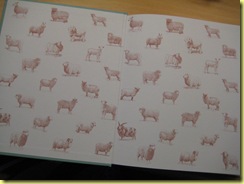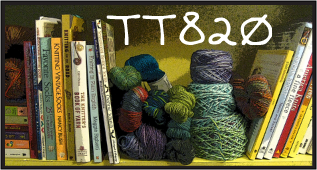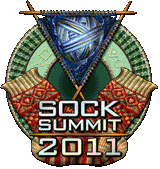Ahhh… The Knitter’s Book of Wool did NOT disappoint. How could a book be bad that begins with these most enticing endpapers?

Here’s the overview:
First, Clara begins by explaining exactly what wool is and how it grows. This chapter is both a biology lesson and an explanation of how the science of wool translates into a knitter’s experience. Great beginning.
Next, we learn about how wool becomes yarn – how it’s sorted, cleaned, spun, and dyed. If you can’t take a behind-the-scenes tour of a mill, this is the next best thing. (Actually, it made me want to take a tour of a mill!) Clara points out what types and parts of wool don’t make it to the knitter’s basket and end up somewhere else in the textile world, instead.
Next, we meet the breeds. Clara outlines the broad categories (finewools, mediumwools, down and down-type wools, longwools, and dual-coated and primitives) and provides more detail about 5-10 specific breeds in each category. We learn the basics about each breed, like the micron range (a measure of fineness), staple length, crimp, luster, its felting qualities, and what it’s best suited for. Often, photographs of washed locks and finished yarns for each breed are also included. This section helped me understand the genealogy of breeds better. Other fun fiber trivia facts are sprinkled throughout this chapter. For instance, a trademarked process called Optim is described, and I wondered if this is the process used on Knit Picks Felici yarn. Also, I learned that the Lord Chancellor of Britain sits on a bale of Cotswold fiber in Parliament to symbolize the historic importance of England’s wool trade. Fun facts.
Clara tucks in one short chapter about blending wool with other fibers. What properties do other fibers like silk, mohair, alpaca, and plant fibers bring to wool yarn? What do you use to blend for seasonal comfort? How about strength? Good stuff with lots of application for handspinners here.
Finally, we reach the meat-and-potatoes (or should I say tofu-and-broccoli) of the book: the patterns. There are 19 patterns in the book, designed by Clara herself or other talented designers whose names you will recognize, and each was designed to showcase a particular type of yarn. For instance, the Sweet Fern Mitts (Rav link) are meant to be made with a woolen-spun two- or three-ply yarn. They could be made from a mediumwool yarn, a down or down-type yarn, or a finewool yarn… with different results depending on your choice. I was instantly interested in knitting this pattern with several types of yarn, many of which reside in my growing stash of homespun. A quick, low-yardage pattern like this is perfect for experimenting with different yarns, commercial and/or handspun.
The end of the book is chock full of reference information, like how to wash wool, how to keep moths away, where to get a fleece processed (either into spinning fiber or yarn), and what to read next. A very fine glossary and detailed index are also included (you know what a wonderful thing a good index is).
I love this book. Reading it is like taking a class with Clara. I can’t wait to knit some of these patterns and understand yarn even better. Thanks, Clara!






You had me at the end papers. And I DO know what a wonderful thing a good index is. I definitely need to get/read this!
ReplyDelete